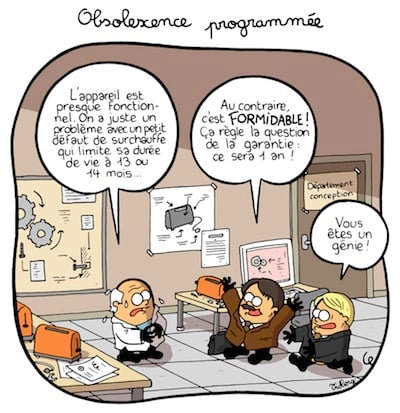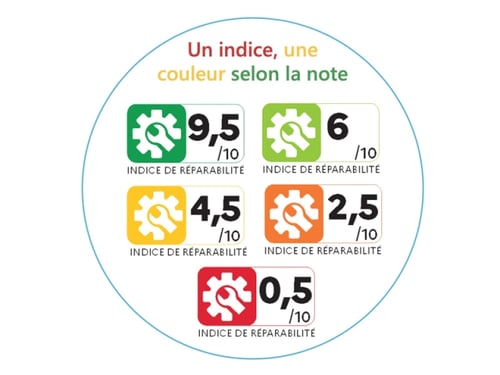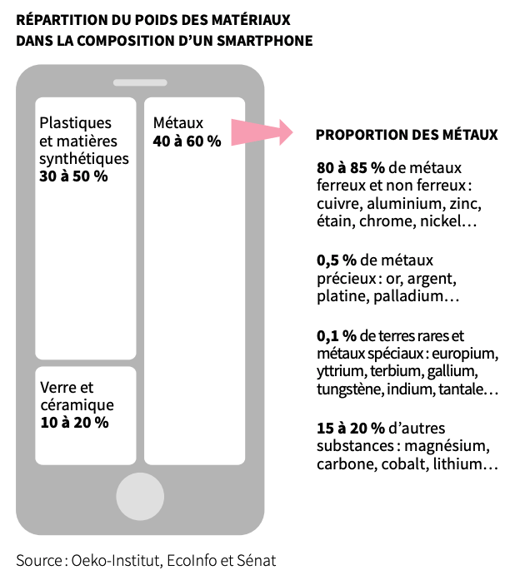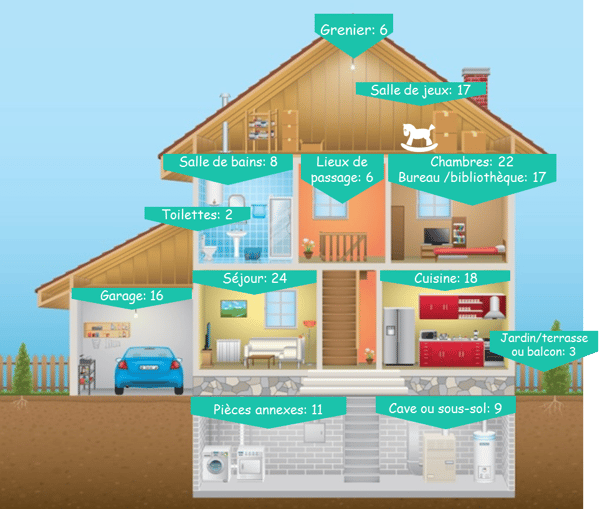Fight against the planned obsolescence of tech products
25/08/2023
0 comments

Planned obsolescence, we often hear about it, but do we really know what it hides ?
Specifically, planned obsolescence is a strategy aimed at reducing the lifespan, and therefore the use of a product. The end goal is to push users to consumption by renewing their devices more frequently.
The beginnings of planned obsolescence date back to 1932, when the American Bernard London identified it as a way to resolve the current economic crisis. In the 1950s, the practice became widespread when industrial designer Brooks Stevens integrated the notion of fashion for everyday objects. Its strategy is to make the buyer feel the need to own a more recent object and a little earlier than what is necessary.
Subsequently, Joseph Schumpeter will integrate the notions of cycle of innovation and creative destruction into the economic model of planned obsolescence.
3 types of planned obsolescence
Technical obsolescenceTechnical obsolescence occurs when a company that has sold us a new product introduces a new product some time later, touted as being more efficient. In reality, the new product will only have a few differences, not necessarily significant compared to the old version. However, the brand in question will not hesitate to use massive amounts of advertising to convince consumers of the absolute usefulness of this new product. The aim is to make a new purchase essential, and to encourage users to renew their equipment as frequently as possible, in order to keep up with the latest trends.
Aesthetic obsolescence
We often talk about aesthetic obsolescence for textile or technological products. In the case of a smartphone, the phenomenon is often combined with technological obsolescence. Aesthetic obsolescence is difficult to punish under the ban on "deliberate" programmed obsolescence practices. Consumers "bear their share of responsibility" for the phenomenon.
Software obsolescence
Finally, software obsolescence refers to the reduction in usability of a digital device (smartphone, tablet, computer, etc.) due to the unavailability or malfunction of software.
 Programmed obsolescence, as seen by Martin Vidberg for Cniid- © Cniid
Programmed obsolescence, as seen by Martin Vidberg for Cniid- © Cniid
Environmental and social consequences
In the digital sector, 75% of the environmental impact is linked solely to the manufacture of digital devices. One of the causes of this is that they are renewed too quickly.
he ever-increasing demand for new high-tech products has a direct impact on the depletion of our planet's resources. In a world where raw materials are not unlimited, it's time to be aware of the impact of our over-consumption. The manufacture of a new smartphone, for example, requires no fewer than 70 different materials. These materials are present in small quantities, and their sometimes complex alloys make many of them difficult to recycle. Around fifty metals are also needed, twice as many as for an old-generation mobile phone. And these metals are becoming increasingly difficult to mine around the world.
On the human side, in order to produce quickly and cheaply, factories are often relocated to countries where working conditions are very difficult. In the south of the Democratic Republic of Congo, for example, UNICEF has identified more than 40,000 children working in mines, many of them in cobalt and coltan mines, strategic minerals used in the batteries and capacitors in smartphones.
What are the penalties ?
It was not until the Energy Transition Act was passed that real measures were put in place, after several years of waiting and failure. Programmed obsolescence is now condemned by article L. 213-4-1 of the French Consumer Code. If the programmed obsolescence of an appliance is proven, the article provides for a two-year prison sentence and a fine of up to €300,000 and up to 5% of average annual sales.
Faced with this phenomenon, consumer associations are taking action. UFC que choisir and HOP (Halte à l'Obsolescence Programmée) are mobilising to reveal and denounce the abuses affecting the general public.
In 2017, HOP filed several complaints against Epson, one of the leaders in the printer and ink cartridge market. An investigation showed that some of the brand's ink cartridges used in the manufacturer's printers indicated that they were "empty" even though 20% of the ink was still available. Unfortunately, in 2021 the complaint lodged by HOP still seems to have come to nothing, but that doesn't mean the association is giving up.
Act against planned obsolescence
Review your needsThe environmental, social and health impacts of producing a smartphone are chilling. As a consumer, it is high time and within everyone’s reach to act on these impacts. For this, before embarking on a new purchase, it is essential to ask the right questions in order to ask if his future purchase is really useful.
-
Do I really need a new device?
-
Can I repair or have repaired the one I use?
-
Is it a need or a desire to have the latest fashionable tool?
On average, a French household has 99 electronic and electrical equipment. From refrigerators to telephones, washing machines, hairdryers, alarm clocks and all small electronic devices, not to mention tools, toys and lighting fixtures, every room in the house passes through.
If we look at connected devices (mobile phones, watches, etc.), we see that a French person has on average 15. While this same average amounts to 8 per person in the world.
Being aware of the social, health and environmental impacts of the products we buy will push us more to be consumers.
Pour le cas d'un smartphone, l'achat de seconde main, permet une réduction d'impact environnemental annuel de 55% à 91% selon les indicateurs par rapport à l'utilisation d'un smartphone neuf. 82kg de matières premières seront préservées et 25kg de GES par année d'utilisation. Au moment de passer à l'achat, il faudra aussi se questionner sur son usage : Ai-je besoin d'un grand écran ? Ai-je besoin d'un navigateur web ou des réseaux sociaux ? Dans le cas d'un usage limité d'un téléphone, ces questions permettront de se diriger vers un appareil plus simple, qui aura donc été moins complexe à fabriquer.
En plus de l'impact environnemental, en choisissant un mobile reconditionné on peut bénéficier d'une réduction de prix allant jusqu'à 50% par rapport à un produit neuf.
En clair, le reconditionné fait du bien à la planète et à son porte monnaie.
For the case of a smartphone, the second-hand purchase, allows an annual environmental impact reduction of 55% to 91% according to the indicators compared to the use of a new smartphone. 82kg of raw materials will be preserved and 25kg of GHG per year of use. When making the purchase, you will also have to question its use: Do I need a large screen? Do I need a web browser or social media? In the case of a limited use of a phone, these questions will allow to move to a simpler device, which will have been less complex to manufacture.
In addition to the environmental impact, by choosing a refurbished mobile you can benefit from a price reduction of up to 50% compared to a new product.
Clearly, the reconditioned does good to the planet and its wallet.
Des alternatives émergentes
The index of reparability
Implemented as part of the anti-waste law for the circular economy, the purpose of the repairability index, which concerns among others smartphones and computers, is to fight against planned obsolescence. It informs consumer purchasing to encourage them to turn to the most virtuous products, in order to reduce the sector’s ecological footprint by increasing the lifespan of devices. A note out of 10 allows to know the capacity, of a smartphone for example, to be repaired by their owner or a provider rather than to be replaced.
Good to know: since November 4, 2022 washing machines, dishwashers, vacuum cleaners and high-pressure cleaners are added to the list of devices subject to the repairability index

The "repair bonus"
It aims to extend the life of electronic and electrical devices. A repair fund now allows individuals to go to one of the 500 first authorized repairers (labeled QualiRépar) and enjoy a discount for the repair of their products. Initially, about thirty devices (out of warranty) are concerned. To support a mobile, users will benefit from an envelope of 25€, and 45€ for a computer. A measure that will strongly encourage users to become consumers by preferring repair rather than new purchase
This is particularly encouraging for the environment and concrete for the most modest households, which are the first victims of planned obsolescence. They suffer a double punishment: because of their purchasing power, they buy goods of poor quality, and these goods must be renewed more quickly.
Dipli simplifies the second life of electronic products.
An all-in-one tool for distributors, leasing companies, telecom operators and companies to manage the entire value chain in one place.
The platform connects the electronics industry to secondary markets; simply and securely. Trade-in and return management, refurbishment, omni-channel purchasing and distribution: Dipli covers and simplifies all stages of the circular economy.







Comments (0)